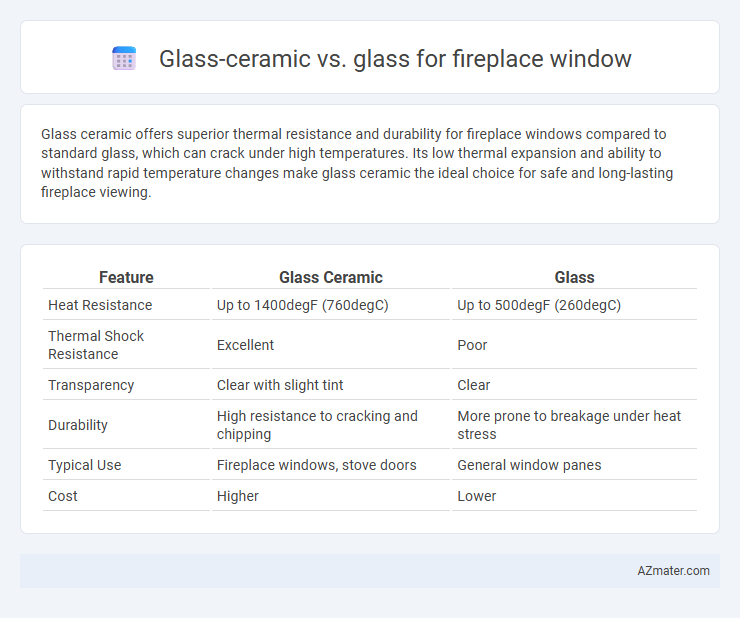Glass ceramic offers superior thermal resistance and durability for fireplace windows compared to standard glass, which can crack under high temperatures. Its low thermal expansion and ability to withstand rapid temperature changes make glass ceramic the ideal choice for safe and long-lasting fireplace viewing.
Table of Comparison
| Feature | Glass Ceramic | Glass |
|---|---|---|
| Heat Resistance | Up to 1400degF (760degC) | Up to 500degF (260degC) |
| Thermal Shock Resistance | Excellent | Poor |
| Transparency | Clear with slight tint | Clear |
| Durability | High resistance to cracking and chipping | More prone to breakage under heat stress |
| Typical Use | Fireplace windows, stove doors | General window panes |
| Cost | Higher | Lower |
Introduction: Understanding Fireplace Window Materials
Glass ceramic offers superior heat resistance and thermal shock durability compared to traditional glass, making it ideal for fireplace windows exposed to intense and fluctuating temperatures. Unlike regular glass, which can crack or shatter under high heat, glass ceramic maintains structural integrity and clarity, ensuring both safety and aesthetic appeal. Fireplaces utilizing glass ceramic windows benefit from enhanced energy efficiency and reduced heat loss due to the material's excellent insulating properties.
What Is Glass Ceramic?
Glass ceramic is a specialized material designed to withstand extreme temperatures, making it ideal for fireplace windows. Unlike regular glass, glass ceramic has a molecular structure that resists thermal shock, allowing it to endure rapid temperature changes without cracking. This heat-resistant property ensures safety and durability, enhancing the performance and lifespan of fireplace enclosures.
What Is Standard Glass?
Standard glass, typically made from soda-lime silica, is less heat resistant and prone to cracking when exposed to the high temperatures of a fireplace. Glass ceramic, such as tempered or pyroceram glass, withstands temperatures up to 700degF or higher, making it ideal for fireplace windows. Choosing glass ceramic ensures safety and durability by preventing thermal stress and enhancing heat insulation compared to conventional standard glass.
Heat Resistance Comparison
Glass ceramic offers superior heat resistance compared to regular glass, withstanding temperatures up to 1400degF (760degC) without deformation or cracking, making it ideal for fireplace windows exposed to intense heat. Conventional glass typically tolerates temperatures only up to 600degF (315degC), increasing the risk of breakage and thermal stress in high-heat environments. The thermal durability of glass ceramic enhances safety and longevity in fireplace applications, maintaining clarity and structural integrity under prolonged heat exposure.
Durability and Strength Differences
Glass ceramic used for fireplace windows offers superior durability and thermal shock resistance compared to standard glass, making it ideal for withstanding rapid temperature changes without cracking. Its strength lies in its ability to endure high temperatures up to 1400degF (760degC), while regular glass typically fails under heat exposure above 400degF (204degC). The enhanced structural integrity of glass ceramic ensures long-lasting performance and safety in high-heat environments, unlike traditional glass which is more prone to breakage and deformation.
Thermal Shock Performance
Glass ceramic outperforms traditional glass in fireplace windows due to its superior thermal shock resistance, tolerating rapid temperature changes without cracking. This material can withstand temperatures up to 760degC (1400degF), making it ideal for high-heat fireplace environments. Conventional glass typically fails under sudden heat fluctuations, risking breakage and compromising safety.
Clarity and Light Transmission
Glass ceramic offers superior clarity and higher light transmission compared to standard glass, making it ideal for fireplace windows that require optimal visibility of flames. Its unique crystalline structure minimizes distortion and enhances the brightness of the fire, providing a clearer and more vibrant view. Standard glass often has lower heat resistance and can discolor over time, reducing both clarity and light transmission.
Safety Features and Breakage
Glass ceramic fireplace windows offer superior safety due to their ability to withstand extreme temperatures up to 1400degF without cracking, unlike standard glass which can shatter under high heat. The low thermal expansion of glass ceramic significantly reduces the risk of breakage caused by rapid temperature changes, ensuring durability and long-term reliability. In contrast, traditional glass poses a higher safety hazard as it is more prone to shattering, potentially causing injuries and releasing hazardous fragments.
Cost Analysis: Glass Ceramic vs. Glass
Glass ceramic fireplace windows typically cost more upfront than standard glass due to their superior heat resistance and durability, which reduces replacement frequency, ultimately lowering long-term expenses. Standard glass windows are less expensive initially but may crack or discolor under high temperatures, increasing maintenance and replacement costs over time. Evaluating total cost of ownership favors glass ceramic for efficiency and safety, despite the higher initial investment.
Choosing the Best Material for Your Fireplace Window
Glass ceramic offers superior heat resistance up to 1400degF, making it ideal for fireplace windows exposed to intense temperatures, whereas standard glass typically withstands heat only up to 570degF. The low thermal expansion of glass ceramic reduces the risk of thermal shock, ensuring durability and safety during rapid temperature changes. Choosing glass ceramic enhances both energy efficiency and longevity, providing a reliable and visually clear barrier for heat containment.

Infographic: Glass ceramic vs Glass for Fireplace window
 azmater.com
azmater.com